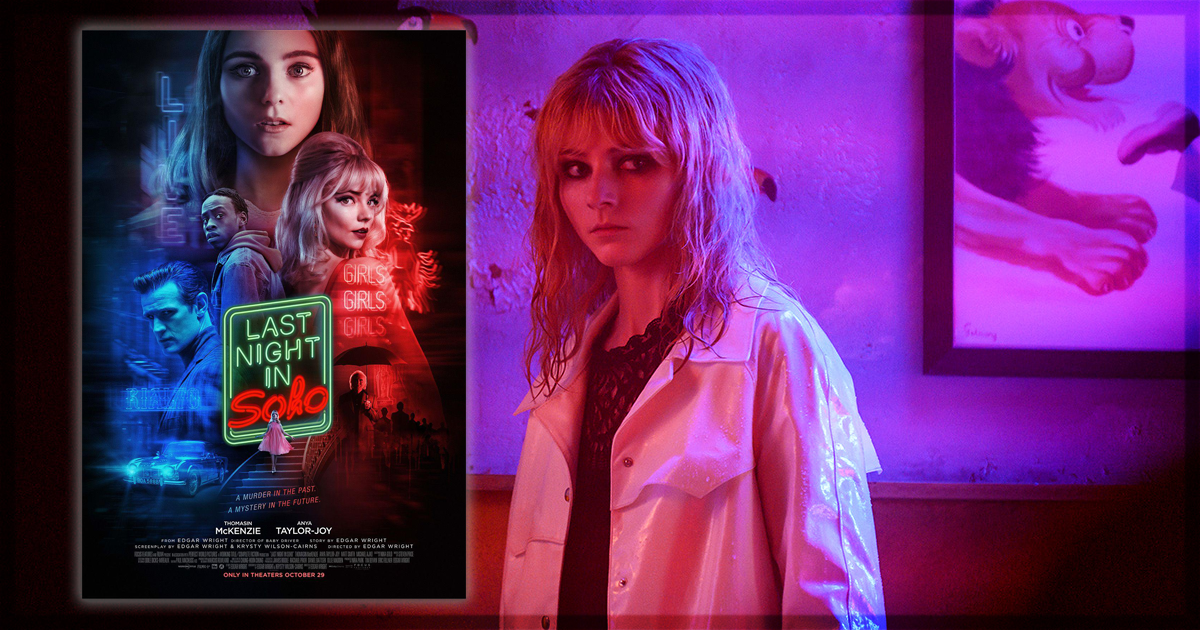Edgar Wright, acclaimed cult director of Baby Driver and Hot Fuzz fame, directs Last Night In Soho with a breezy smoothness, but this vibrant, pulpy horror is disappointingly toothless.
In contemporary Cornwall, naive and fresh faced 18 year old Eloise ‘Ellie’ Turner (Thomasin McKenzie) is standing in her room. Fashion strewn across the floor as she dances in front of the mirror, imagining her future as a famous designer. A letter arrives: she’s going to London fashion school! But that’s where her late, schizophrenic mum went and couldn’t hack it because “London is a big scary place”! Even so, off she goes, bright faced with big dreams, the (literal?) spirit of her mum standing over her shoulder. Quickly realising her ‘country girl’ quirkiness doesn’t fit in with her peers in student accommodation, she finds herself finding the perfect flat in Soho with cold landlady Miss Collins (the late Dianna Rigg in her last, but brilliant, on screen performance). It’s dusty and dated but it reminds her of her favourite era, 60’s London, and she falls in love with it.
Falling asleep underneath the neon glow of a French bistro, she finds herself transported through time in her sleep. Whilst dreaming, she inhabits the body of Sandy (Anya Taylor-Joy), a confident blonde bombshell with high hopes for her life as a star in London. Soon, the dreams become a reality that Ellie would rather prefer. She begins to take inspiration from her fantastical dreams and mimic Sandy in her modern day life, changing from her natural brunette to Sandy’s bouncy blonde curls. As the timelines blur, the ghosts of the past come haunting up through the creaky floorboards as Ellie discovers her dreams are visions of the past, and when Sandy is murdered, Ellie sets out on a mission to find the person who murdered Sandy, whatever it takes.
When you think of Edgar Wright and horror, you think of his previous foray into the genre Shaun of the Dead, a film which is more comedic in value than scary. Last Night In Soho wants to be horror. It wants to homage Dario Argento’s Suspiria, Wes Craven’s Nightmare on Elm Street along with countless others that Wright obviously views fondly, but it comes across as a little cheap (Or expensive, depending on how much the CG to replicate some of these shots cost). The CGI ghosts give bland jump scares, while the so-called body horror is all fake blood – and feels it. The film is so much tamer than it wants to be, and the build up to its climax is repetitive. The result is a film that is a patchwork of better movies, made without the terror that is entrenched into the seams of those films.
It’s still a very pretty film, potentially Wright’s best on a visual front, and has some glorious panache to its shot selection. The smooth edit of Ellie and Sandie switching places while dancing with Jack (A hammy Matt Smith, who has surprisingly little to do here) is a highlight. It’s such a delightful scene that serves to bookend ideas of what’s to come. But Wright tries very hard to impress with scenes like this, in that it just feels a little bit plastic and unnatural. Wright styles himself with quick edits and visual character cues, but he wants this to brood. He wants this to thrill and scare, and it just doesn’t reach those emotional heights where he wants and needs it to. By not signifying itself with Wright’s individual style, it loses a step.
It does hit grand heights during the first act. A dry eye is not to be found as Ellie tells her Grandmother (Rita Tushingham) that she’s “doing it for her”, indicating her mother’s attempt to break into the fashion industry that contributed to her suicide. Ellie’s time finding her feet in scary London – a flat, a job, a friend – is full of whimsy coming-of-age charm and it is sweet and fun. This is done while indicating that the message of the film will be about the intimidating actions of men, indicating often that it will deal with ideas surrounding the ‘Me Too’ movement. Ellie leaves a taxi early after being made uncomfortable by the male driver, moves away from a drunk student who is in her personal space, and plays around with the idea that the men involved in Sandy’s life were literal demons.
However, as Last Night in Soho goes deeper into thrill, the amusement wanes, this message becomes muddled, and especially in its third act, it ends up feelings as lifeless as the ghosts stalking Ellie. When the third act does start poking its way through, specifically when Sandy’s career takes her on an unexpected turn, the message of the film becomes a hodgepodge of rewrites and already feels outdated for the current climate in 2021. Progressive ideologies don’t always have to be entertained within art, but it’s one that begs to be taken seriously throughout and Wright’s writing, along with 1917 scribe Krysty Wilson-Cairns, lacks the insight and nuance required for these discussions. A message as important as ‘Me Too’ deserves not to be sidelined in favour of cheap thrills.
Last Night In Soho is sporadically entertaining, but scares cheaply and undercuts its own message. A star turn by Thomsasin McKenzie helps make this hollow pastiche a diverting enough time if you turn off your brain. Which, perhaps, we should never need to do.
Last Night in Soho is now available to purchase or stream however you like to enjoy movies.


